Physical Address
304 North Cardinal St.
Dorchester Center, MA 02124
Physical Address
304 North Cardinal St.
Dorchester Center, MA 02124
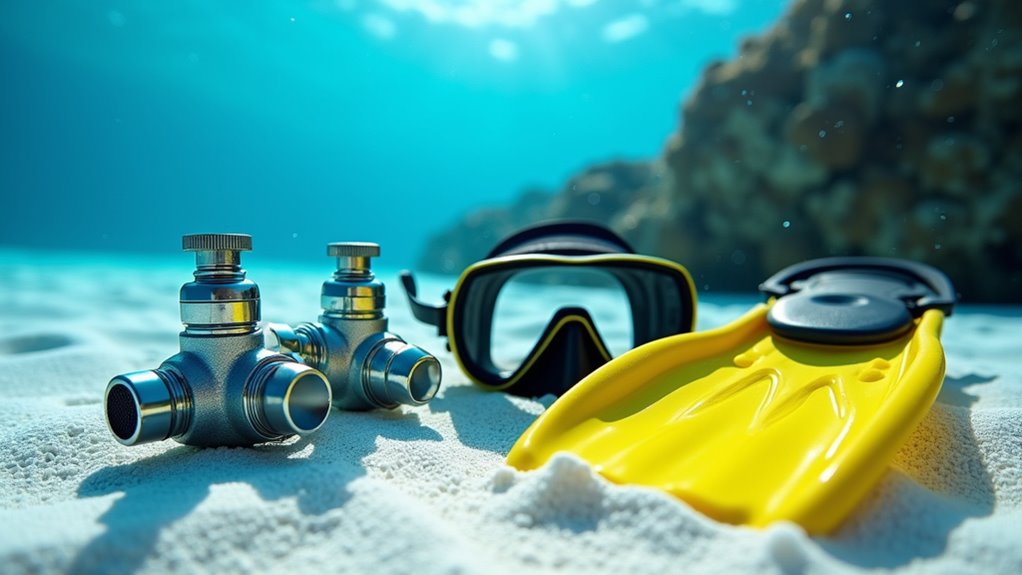
Never let neglected scuba gear ruin your dive—discover seven essential maintenance tips that could save your life underwater.
Your scuba gear represents a significant investment, but more importantly, it’s what keeps you safe underwater. You’ve probably experienced that sinking feeling when something doesn’t work quite right during a dive – maybe your regulator breathes harder than usual or your BCD won’t hold air properly. These issues don’t just happen overnight; they’re usually the result of neglected maintenance. Here’s how you can prevent costly repairs and potentially dangerous equipment failures before your next underwater adventure.
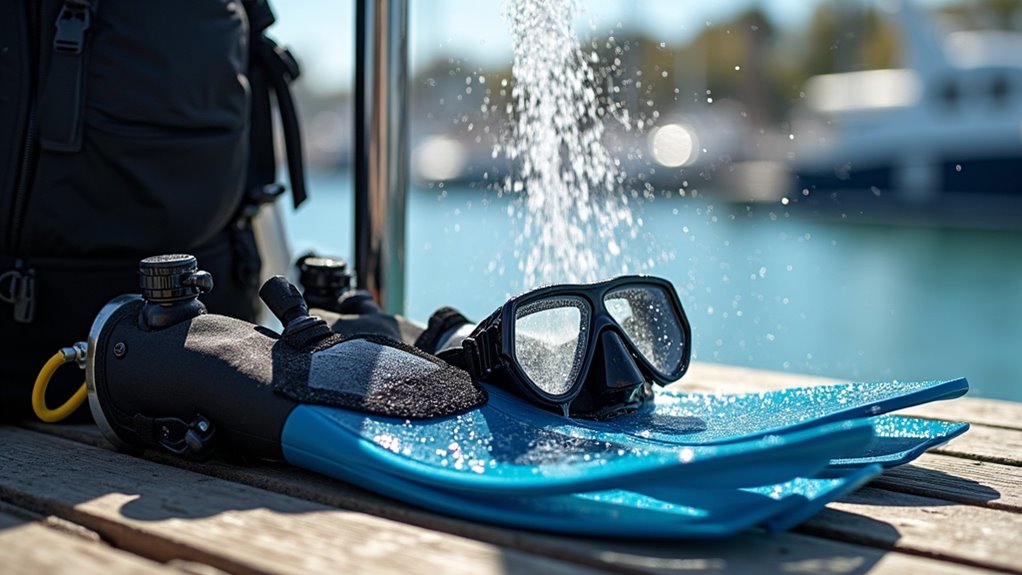
After every dive, you’ll want to rinse all your equipment with fresh water as soon as possible. Salt water and chlorine are your gear’s worst enemies, causing corrosion and damage over time. Don’t just give everything a quick splash – thoroughly rinse each piece for at least 30 seconds.
Pay special attention to your regulator, BCD, and wetsuit. For your regulator, keep the dust cap on while rinsing to prevent water from entering the first stage.
Rinse your BCD inside and out by adding fresh water through the oral inflator, swishing it around, then draining completely.
Your mask, fins, and wetsuit need attention too. Remove any sand or debris, and make sure you’ve cleared all salt residue. This simple step dramatically extends your equipment’s lifespan. If you’re diving in remote locations where fresh water may be limited, consider bringing portable water purifiers to ensure you have clean water available for equipment maintenance.
Once you’ve properly rinsed your gear, finding the right storage spot becomes essential for preventing damage. Heat and humidity are your equipment’s worst enemies, causing rubber to deteriorate and metal components to corrode faster.
Heat and humidity will destroy your gear faster than anything else, making proper storage location absolutely critical for equipment longevity.
Choose a storage area that maintains consistent temperatures and low humidity levels. Your garage or attic won’t work if they experience extreme temperature swings.
Here’s what to look for in proper storage conditions:
Avoid basements prone to dampness or areas near heating vents. A climate-controlled closet or dedicated equipment room works perfectly.
Just like outdoor enthusiasts who rely on camping showers to maintain hygiene in remote locations, divers need consistent maintenance routines to keep their gear performing reliably in challenging underwater environments.
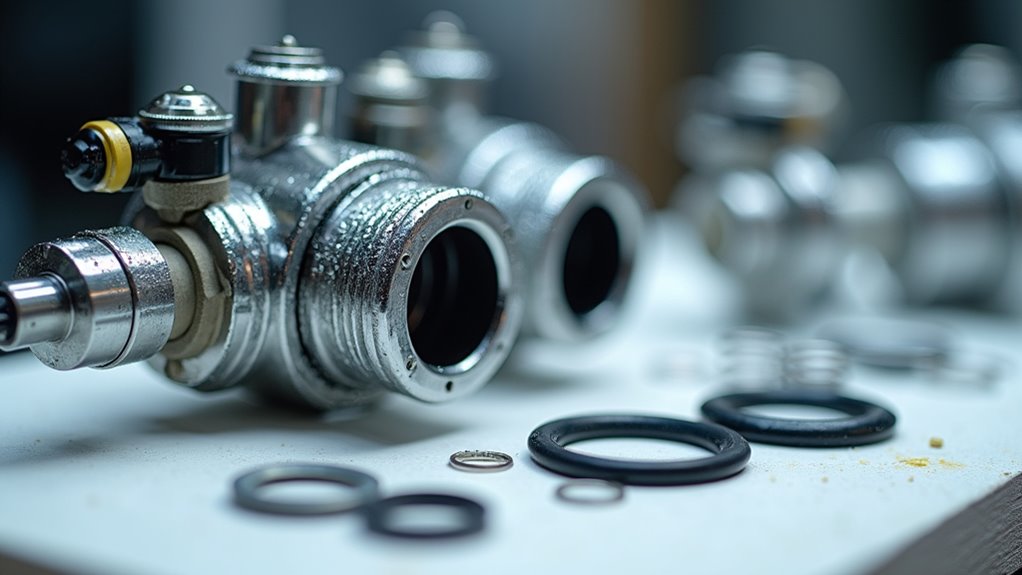
Your regulator serves as your lifeline underwater, making regular professional servicing non-negotiable for safe exploring. Most manufacturers recommend annual servicing, though this varies by brand and usage frequency. Don’t wait until you notice problems – internal components wear gradually and can fail without warning.
Schedule servicing with certified technicians who specialize in your regulator’s brand. They’ll replace O-rings, seals, and filters while checking breathing resistance and air delivery rates. Keep your service records organized, as some manufacturers require documented maintenance to honor warranties.
If you’re a frequent diver or dive in harsh conditions like saltwater or cold environments, consider more frequent servicing every six months. The cost of professional maintenance is minimal compared to equipment failure risks underwater. Having reliable scuba diving gear ensures you can fully experience the delight of underwater exploration without compromising your safety.
While professional servicing handles major maintenance, you’ll need to inspect O-rings and seals yourself between service intervals to catch potential problems early. These small rubber components prevent water from entering critical areas of your equipment, making them essential for safe diving.
Check your O-rings before every dive trip and after saltwater exposure:
Don’t ignore worn seals. A fifty-cent O-ring failure can flood expensive regulators or cameras, potentially creating dangerous situations underwater. Failing to properly maintain your O-rings and seals ranks among the most common scuba diving mistakes that can be easily prevented with regular inspection.
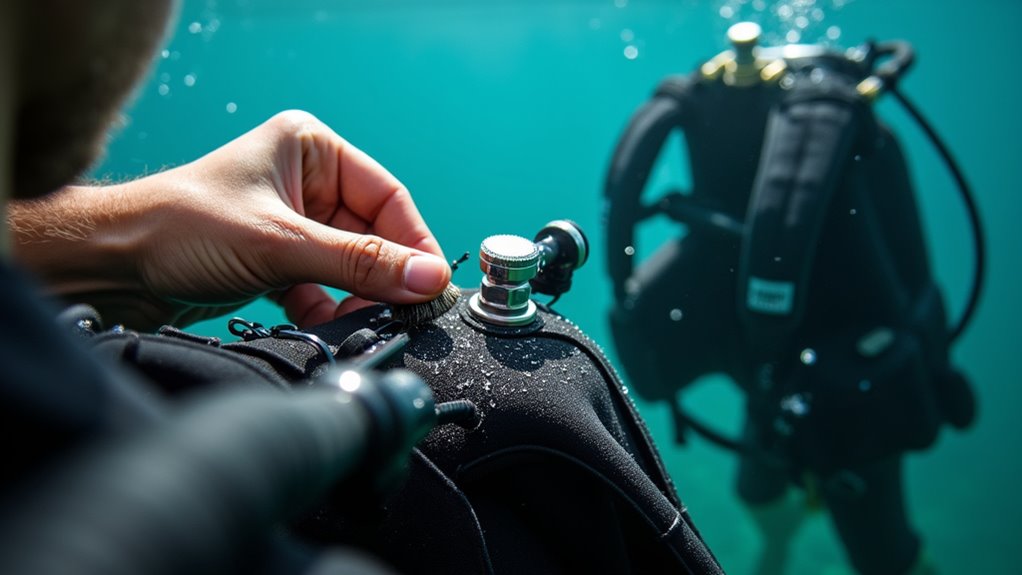
Because your BCD (buoyancy control device) keeps you neutrally buoyant underwater, its inflation system needs regular attention to function reliably when you need it most. Start by testing your inflator button before each dive—press it to ensure smooth air flow without sticking or hesitation.
After diving, rinse the inflator mechanism thoroughly with fresh water, paying special attention to the button area where salt crystals love to accumulate.
Monthly, disconnect your inflator hose and inspect it for cracks or wear. Look inside the BCD for moisture or debris that could block air pathways.
Don’t forget your oral inflator—blow through it occasionally to clear any blockages. If you notice sluggish inflation or deflation, have a technician service it immediately rather than risking equipment failure underwater.
Beyond keeping your BCD’s inflation system in top shape, you’ll want to give equal attention to the gear that protects you from the elements. Your wetsuit and exposure protection require consistent care to maintain their protective qualities and extend their lifespan.
Here’s how to properly maintain your exposure gear:
Proper storage means keeping your wetsuit in a cool, dry place. Don’t fold it tightly or leave it in hot cars where extreme temperatures can damage the material. Just like Scotland’s West Highland Way offers some of the world’s most stunning underwater visibility for cold-water diving, maintaining your exposure protection ensures you can fully enjoy these spectacular dive sites.
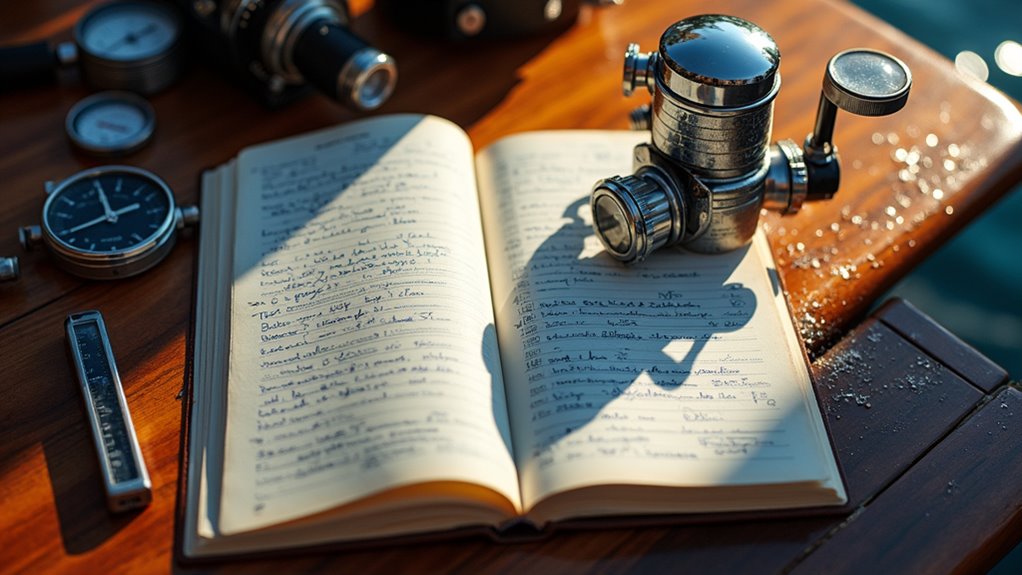
Just as pilots maintain detailed flight logs, you should track every aspect of your scuba equipment’s maintenance history. Create a simple logbook or digital file documenting service dates, repairs, and equipment performance. Record regulator services, tank hydrostatic tests, and computer battery replacements with exact dates and service provider details.
Note any unusual behavior like slow inflation, sticky valves, or computer malfunctions before they become serious problems. Include dive counts, depth exposures, and environmental conditions your gear has experienced. This information proves invaluable when troubleshooting issues or determining service intervals.
Keep receipts and warranty information organized alongside your maintenance records. Many dive shops offer discounts for well-documented equipment, and detailed logs help technicians diagnose problems faster, potentially saving you money on unnecessary repairs. Don’t forget to document mask maintenance procedures, including mask defogging techniques and any anti-fog treatments applied to ensure optimal visibility during your dives.
You’re one dive away from disaster—or decades of underwater adventures. It’s your choice. Skip that post-dive rinse, and you’ll watch rust devour your regulator. Ignore those cracked O-rings, and you’ll face equipment failure at 60 feet. But treat your gear like your life depends on it, because it does. Clean, inspect, service, record. Your future self will thank you when you’re exploring coral reefs instead of shopping for replacement equipment.